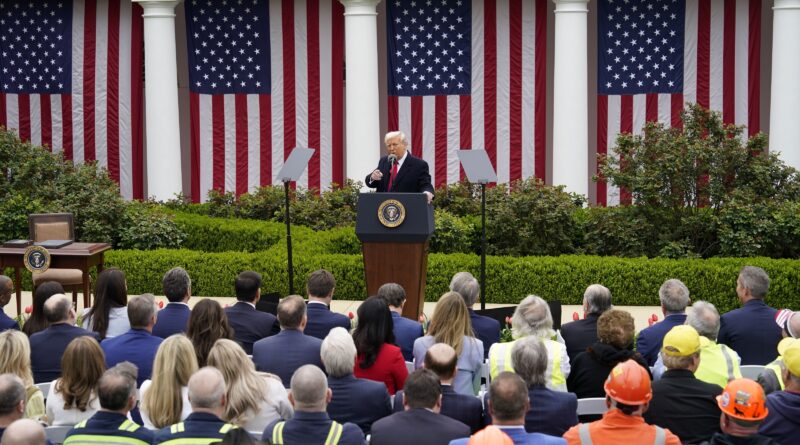Trump and von der Leyen Reach Crucial Trade Agreement Amid Tension
On a Sunday, 27 July 2025, a significant trade agreement was reached between US President Donald Trump and European Commission President Ursula von der Leyen on the greens of Trump Turnberry golf resort in Turnberry, Scotland. This marked the culmination of tense negotiations that almost led to a major escalation in tariff wars between the two world powers. Representing the countries of the European Union, von der Leyen managed to stave off an impending 30 percent blanket tariff that was due to be enforced from the 1st of August. Nonetheless, the deal has sparked a split amongst European leaders over the price of the compromise.
The eleventh-hour agreement resulted in an arrangement that positions a 15 percent tariff on EU exports heading into America. Thus, averting a potentially catastrophic trade conflict and achieving immediate stability. However, this agreement has not been free of its critics. Key figures across Europe, including France’s Minister for Europe, Benjamin Haddad, quickly expressed their reservations, highlighting the trade-off for temporary stability as ‘unbalanced’.
The deal was finalized amidst a charged atmosphere at Trump’s Scottish golf resort. Trump revealed in triumphant spirits that the reaching of this agreement was of paramount importance, characterizing it as ‘probably the biggest deal ever reached in any capacity’. The key terms of the deal lay out a uniform 15 percent tariff that will be applied to EU goods such as automobiles, pharmaceuticals and semiconductors. As a part of the agreement, the European Union has pledged to procure €690 billion worth of US energy, including the likes of liquefied natural gas, oil and nuclear fuel, over the coming three years.
Alongside the considerable commitment to energy purchases, the EU is set to invest another €550 billion into the US. Trump also hinted towards significant purchases of defence equipment by European NATO members. Representing the interests of every EU nation, Von der Leyen embarked on a challenging task to protect a trading relationship valued annually at €1.6 trillion.
While Trump’s 15 percent tariff was not von der Leyen’s ideal outcome, she acknowledged that mitigating a huge tariff hike was a significant accomplishment. ‘It will bring stability. It will bring predictability. That’s very important for our businesses on both sides of the Atlantic,’ she commented. But she added a cautionary note, pointing out that even a 15 percent tariff ‘is not to be underestimated, but it is the best we could get.’
In an effort to offset this larger tariff hit, the EU Commission chief pointed to some positive developments. She shared that tariff exemptions were agreed upon for certain ‘strategic products’, which would include aircraft, select agricultural goods, chemicals, and specific vital raw materials. Von der Leyen also harboured optimism that zero-tariff deals may be secured for certain products like alcohol in the future.
However, the reactions to this deal across Europe were quite mixed. German Chancellor Friedrich Merz praised the agreement, lauding the avoidance of an unnecessary escalation. However, industry groups expressed criticism, worrying about the future of their business prospects with the new tariffs.
Notably, Germany’s BDI federation issued a strong warning against the impending ‘considerable negative repercussions’ for their exporters. Similarly, the VCI chemical lobby expressed their concern over the rates, deeming them ‘too high.’ These reactions indicated that securing the deal may not be a complete victory for European businesses.
In Ireland, a country whose economy heavily relies on US exports, the trade agreement was met with a welcome sigh of relief due to the clarity it offers. However, they could not help but voice a ‘regret’ over the establishment of the tariff baseline. This overall response perhaps indicates the bittersweet nature of the deal for many European nations.
One particular area where disputes persist is over steel. Trump, during the announcement, made a point to indicate that the tariffs on steel from the EU would continue to stay in place, despite the EU’s hope for a compromise based on quotas. This was yet another issue added to the list of contentious points in the deal that some EU nations weren’t too pleased about.
While Trump seemed steadfast on retaining the current steel tariffs, von der Leyen stated that a quota system and tariff reductions would, in fact, be implemented in the future. The specifics of how this would work, however, remained unclear, adding to the list of uncertainties.
With all these varying elements and reactions at play – from the short-term stabilization and volatile criticism to the glimmers of optimism – the agreement marked the end of a high-stakes standoff that was hanging in balance over the Atlantic. It’s important to remember that this seemingly solid compromise is a temporary solution, a stepping stone toward a more balanced and fair trading relationship.
Reflecting on this historic agreement, it’s clear that the path to it was filled with urgency, tensions and high stakes for all involved. It’s a prime example of political negotiation at work where the ideal outcome may not always be achievable, but still, a middle ground must be found. It’s a compromise that focused as much on averting a crisis as it did on securing a future direction.
As this agreement unfolds and its consequences ripple out, businesses, governments, and individuals across both continents will be keenly observing. There will be considerable scrutiny on how this balance of power is maintained and how it influences the broader global economic and political landscape.
Despite some criticisms, it’s undeniable that this agreement has at least momentarily averted what could have been a damaging tariff war. As von der Leyen succinctly put it, the agreement will bring stability and predictability, two elements vital for businesses on both sides of the Atlantic.



